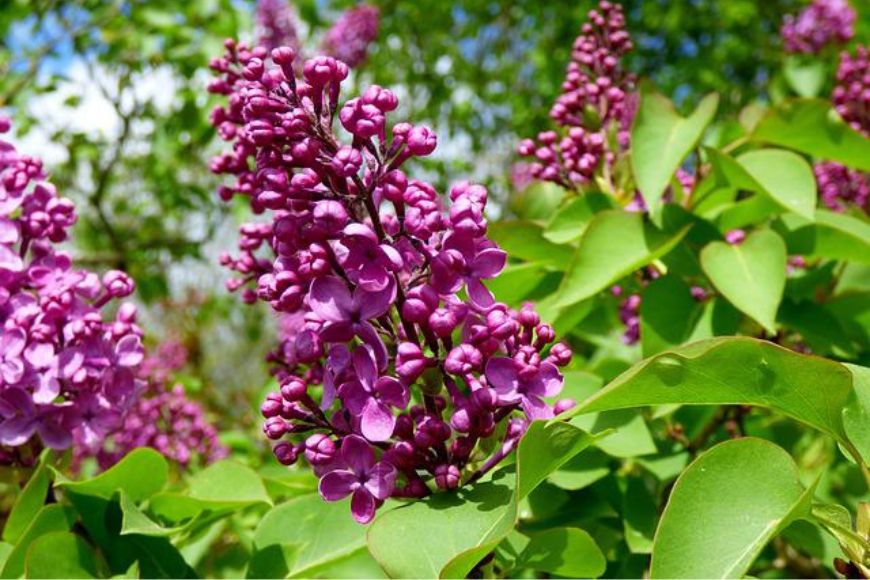
Lilacs and You: Planting and Care
Are you looking for a fragrant, easy to grow shrub that will add beauty to your yard? Look no further than the old fashioned (or should we say “timeless”) lilac. They are easy to grow and covered with wonderfully scented blossoms during the spring. Plus, lilacs are a great long-term investment–they often last longer than the house that they are planted near.
A Brief History of Lilacs
In Greek mythology, a nymph named Syringa was pursued by Pan, the half-man, half-goat god of groves. She found that she could not get away from him, so she turned herself into a flower–the lilac.
Lilacs were introduced to Europe in the 16th century and to America about 200 years later. They are in the olive tree family and will grow to 20 to 30 feet high and usually have shoots growing from the base so that they form a dense bush. Most are various shades of violet, but there are white, yellow and pink varieties as well. There are about 20 varieties of lilacs of various sizes and colors, so you should be able to find one or several to enhance your landscape.
Planting Your Lilac
One of the best things about lilacs is that they are easy to care for. You can plant lilacs in either spring or fall. Keep them watered and pruned, and you will have a beautiful bush that could outlive you.
Soil
Lilacs love well-drained soil, rich in organic matter. If yours is sandy or has a lot of clay, you can work compost into it to help it drain more effectively and keep the roots from rotting. They also like their soil neutral to slightly alkaline, so if yours is slightly acidic, you might want to add a little lime to raise the pH.
Light
Your lilac will do best in full sun, but if you have a place you want to add a little spring color or need some deep green foliage through the summer, they will do well in partial shade as well. When you are deciding where to put them, remember that they do better if they have a slight breeze flowing through the foliage, so don’t plant them up against a wall or a fence or in large clumps.
Transplanting
When you are ready to plant your lilac, dig a hole a few inches deeper than the root ball and about twice as wide. Remove the root ball from the container and place it in the hole. You will want to fill in the dirt so that the root ball is a couple of inches below ground level. Water it well once it is in the ground, then water it regularly as the roots begin to grow into the new soil.
Growing and Maintaining Your Lilac
There really isn’t a lot to do once your lilac is in the ground. They are very healthy and need very little maintenance. So there is less work for you, giving you more time to enjoy the fragrant blossoms.
Composting
Early in the spring, you will want to feed your lilac a little. Spread some well-composted plant matter under the branches and spread it evenly a few inches deep. This will provide nutrients for your plant, giving you plenty of blossoms and foliage. After your lilac finishes blooming, you will want to add a little composted manure around the base to keep it growing happily throughout the summer and fall.
Fertilizing
Believe it or not, lilacs aren’t partial to fertilizer. Compost is about all that you need. If you feel the need to fertilize, give your lilac just a little 10-10-10 in late winter.
Mulching
After composting, spread a layer of mulch to help control the weeds and retain moisture. A heavy layer of mulch or bark will keep the grass from stealing nutrients that your bush needs to give you the best blooms.
Watering
Generally, lilacs don’t need water. But if you have a very hot and dry summer, you will need to water them. They need a good watering about once a week, so if nature doesn’t provide an inch of rain, you will need to get the hose out and soak the ground around your plant.
Pruning
You will want to prune your lilac bush soon after it finishes blooming in the spring. The blooms grow on 2nd year growth, so you need to prune soon after the blooms fade or you might not have many flowers in the following spring.
Try to prune away enough branches to open up the bush because airflow and sunlight will help keep them disease-free.
Cut the oldest canes off at ground level, along with any suckers that you don’t want growing. Look for dead and dying branches. Cut those back to healthy wood.
If your lilac gets big and unmanageable, you can cut the whole bush down to the ground and let it start over. They are very hardy and will bounce back soon, but you need to remember that it could be two or three years before it blooms again.
Pollinators
While the blossoms don’t last long, your local pollinators will love them while they are in bloom. Spend a little time watching the honey bees buzzing from cluster to cluster and the butterflies floating and fluttering from blossom to blossom for little sips of nectar.
Live, Live, and Lilac!
You really don’t need to be an experienced gardener to grow lilacs. Just find a place in your yard where they will be happy, compost and mulch, water when needed and then prune them after the blossoms fade. Do that and you will have your entire yard flooded with the delicious fragrance during spring.
